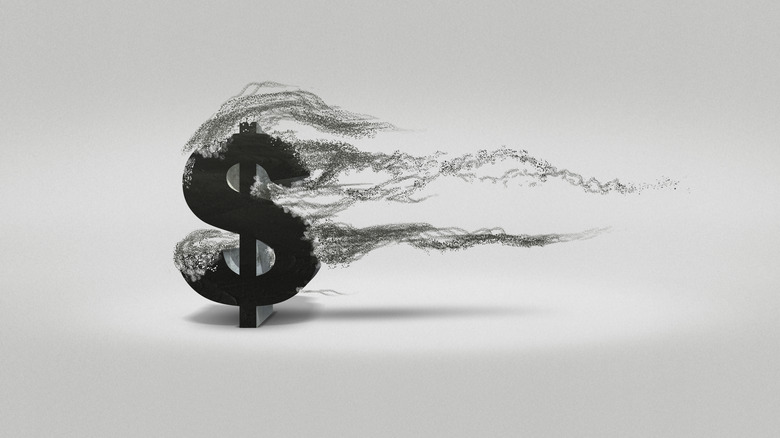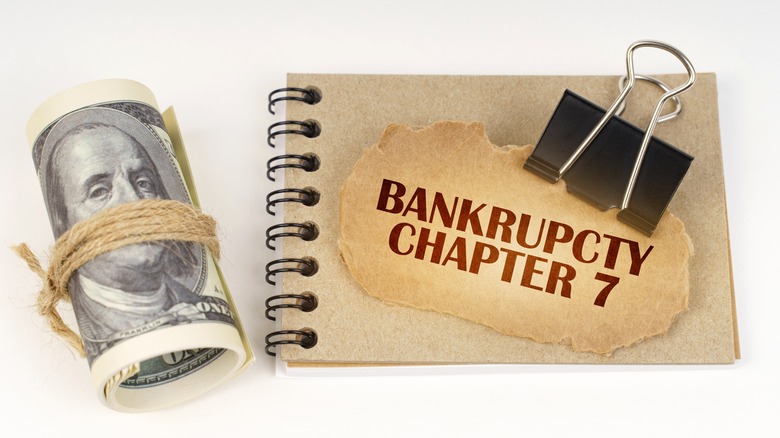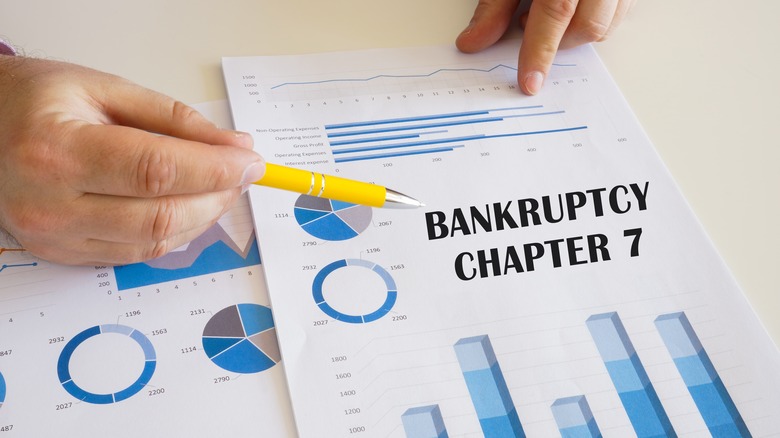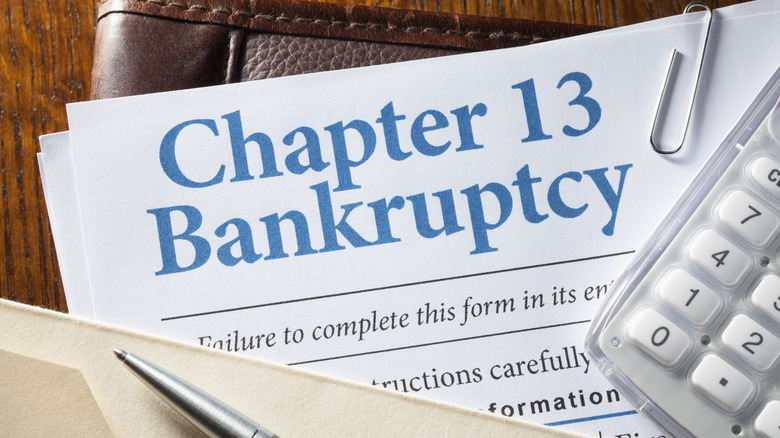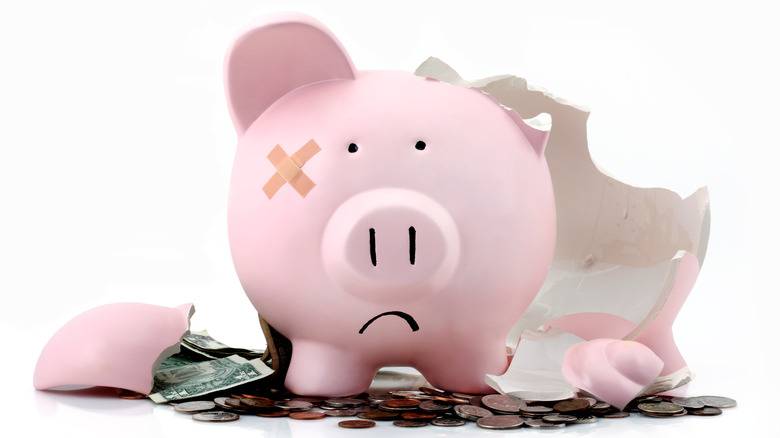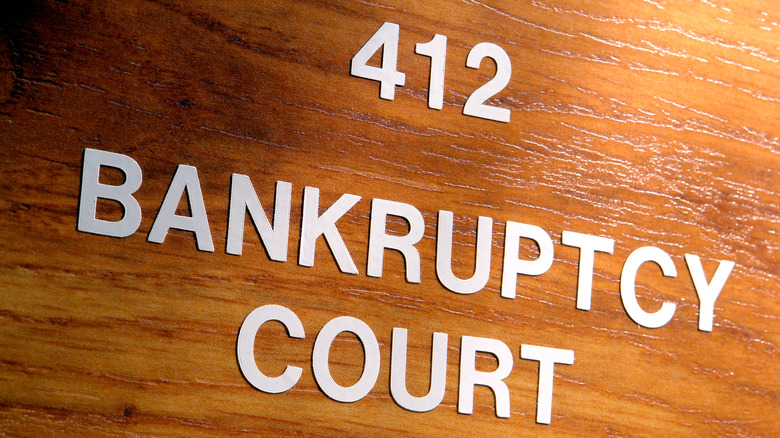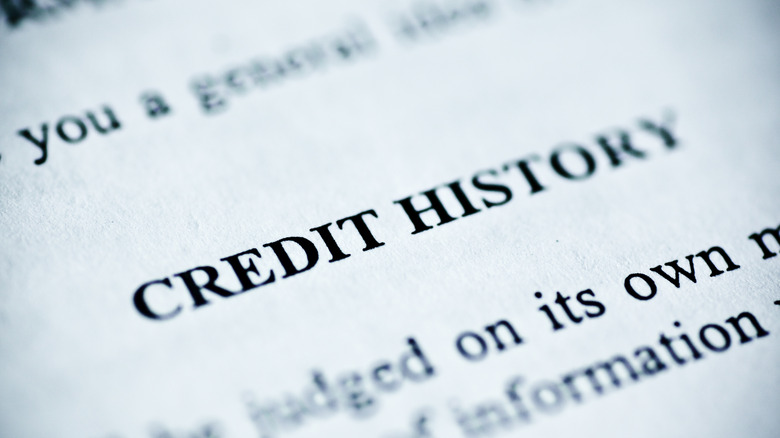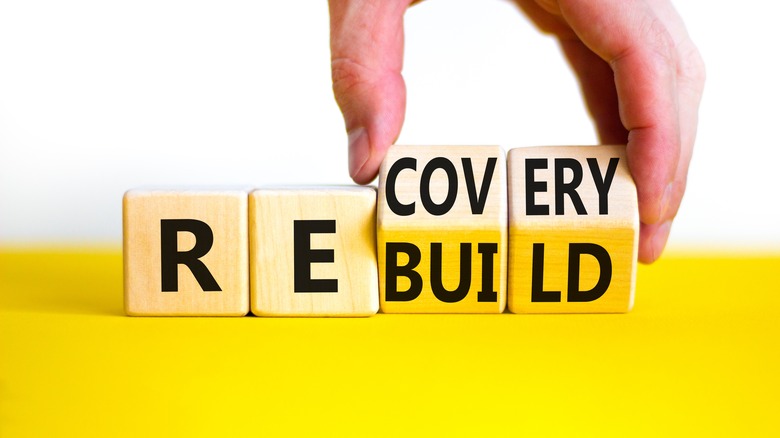What Really Happens When You Go Bankrupt (And How To Recover)
Most adults understand the basics of bankruptcy — except maybe Steve Carell's iconic Michael Scott from "The Office." It's a financial decision that almost 400,000 people in the United States made in 2022, and represents a drastic step to overhaul individual finances. Bankruptcy is well understood as a concept, but it's likely that most consumers don't really know how the process works. This means that entering into bankruptcy proceedings can come with an added layer of anxiety and a near-total lack of practical knowledge. Anyone filing for bankruptcy will want to speak with a lawyer who specializes in these types of cases. It's possible to file the paperwork and work through the process without representation, but it's a bad idea for all but the most knowledgeable filers.
Even with legal help, bankruptcy can feel like a dramatic and unrelenting challenge. From understanding the correct bankruptcy type to making fiscal calculations surrounding income and dischargeable debts, it's a long and hard road. And that's to say nothing of the shockwaves that come after a bankruptcy has been finalized. Before going down the road of bankruptcy — which is a legitimate and viable means of debt management in certain circumstances — it's critical to understand the nuances and consequences of the process. You may lose some of your nonessential assets, like a house or car, and your credit will likely be trashed for many years. But there are a number of incredible benefits that this relief opportunity can bring about, too.
First, take a long hard look at your finances to determine if bankruptcy is the right move
The first and most important step in any move toward bankruptcy is a very hard look at your existing financial picture. Bankruptcy, as you'll see, isn't the end of the world but it is a significant undertaking and a very big deal. No one should decide to take this step lightly. Bankruptcy is a process of last resort for those experiencing truly dire financial circumstances. The process of filing for bankruptcy and following it through to the issuance of a discharge will tarnish your credit score and may close off the potential for new borrowing opportunities of virtually every kind for the foreseeable future.
Bankruptcy isn't suitable for most consumers and generally speaking, it's a better idea to work out a payment plan or consider debt consolidation loans and other financial options to deal with a significant debt burden. Experts suggest that an effective yardstick for measuring if bankruptcy is a viable solution for any particular borrower whether or not a 'feeling of financially drowning' has come into the picture. Everyone's individual ability to withstand the stress of significant financial instability will be different, so no two consumers should determine if bankruptcy is a good idea or a step too far against the same standardized criteria.
Bankruptcy isn't something to be ashamed of
Moreover, one component of the bankruptcy process that often gets overshadowed is the essential fact that bankruptcy isn't something that filers should be ashamed of. Filing for bankruptcy is an indication that you've fallen on drastically hard times. This dilemma can certainly come as a product of wasteful spending and wanton consumerism, buoyed by multiple credit card accounts. But just as irresponsible spending can quickly rack up so too can the fallout from medical debt after an accident or sudden illness. A wide range of factors can contribute to an individual's choice to utilize a bankruptcy filing and yet none of these signify anything about your character or personal worth.
Bankruptcy is a viable means of remedying extreme fiscal difficulty, nothing more. It's also a tool of last resort that can help you stay in your home if other financial burdens have become too much to handle. Essentially, bankruptcy restructures your debt load in a way that allows you to create a new, manageable repayment schedule or shed much of your existing debt entirely through a more drastic approach.
Chapter 7 versus Chapter 13 bankruptcies
If the math adds up in your personal financial circumstances, then contemplating the choice to use one of two avenues for bankruptcy filing is the next step in the process. Chapter 13 bankruptcy is more common for the typical consumer, but Chapter 7 bankruptcy fits the more traditionally envisioned model of the procedure.
When filing for Chapter 13 bankruptcy, you're likely to pay more in legal fees. However, many firms are willing to create payment plans or collect their payment after the process is complete, keeping in mind that a discharge lies three to five years down the road. With a Chapter 13 bankruptcy, consumers build a new payment plan with creditors that provides monthly payments to make lenders (somewhat) whole, while creating essential debt relief for borrowers who find themselves in over their heads. In this type of bankruptcy, you'll get to keep anything you might have bought on credit accounts headed toward discharge, and the procedure acts more like debt restructuring than elimination.
A Chapter 7 bankruptcy is a more straightforward route in which nonessential belongings (like investment properties and some types of savings and consumer assets) are surrendered and a few months after beginning the process, the discharge of your debts is completed. There's no one-size-fits-all approach to bankruptcy, and your unique circumstances will dictate which type of bankruptcy approach will be the most effective.
A means test is applied to determine eligibility for Chapter 7 bankruptcy
Beyond a few standard requirements, such as existing as a person rather than a business entity or maintaining a permanent residence in the United States, Chapter 7 bankruptcy is limited to those with low income figures. First, calculate your average income over the preceding six months and compare it to the median figure for your state and family size. If your income is at or below this threshold, you are eligible to file a Chapter 7 bankruptcy. The U.S. median income reported by the Census Bureau for 2022 estimates all households at $74,580 per year, while single female households earn an estimated $40,200 per year and married couples roughly $110,800. Statista estimates that Mississippi sports the lowest annual median income across all households at $48,610 while Maryland exhibits the highest, more than double that figure and standing at $108,200.
Even if your income is above the state-specific threshold governing your case, you still may be eligible to file a Chapter 7 bankruptcy. A means test is then applied to determine your realistic ability to pay off some of your total unsecured debts over the three-to-five-year period to follow. Essentially, this determines if you can actually afford to file a Chapter 13 bankruptcy and follow through on the repayment plan. If your disposable income (less exempt expenses like transportation and housing costs) rises to a level that makes repayments affordable, you'll have to file for Chapter 13 bankruptcy instead.
If you file Chapter 13 bankruptcy, diligence is key
A Chapter 13 bankruptcy creates a repayment plan that will see you pay down some portion of your listed debt load. This will typically span over three to five years, allowing for a concerted commitment to pay off some of the accrued burden while keeping your possessions. This is a massively valuable asset for anyone inching dangerously close to losing their home in foreclosure. During the bankruptcy process, the court will issue an automatic stay, preventing creditors from seizing your assets. This gives you the repayment term — a three-to-five-year window — to catch up on overdue payments on your home and avoid losing it. The stay will be lifted once the debts are discharged, however, so the protection won't last forever. You also can't use bankruptcy to defraud creditors, purposefully targeting a mortgage in an effort to stop paying or drastically reduce the amount owed.
Even with the important protections in place during a Chapter 13 bankruptcy, diligence is crucial. If you miss even one payment, the arrangement can be nullified by the court, leaving you back where you started, and unable to fall back on a fresh bankruptcy filing for two years. The harsh reality is that two-thirds of Chapter 13 bankruptcies don't make it all the way to discharge.
Many who file for bankruptcy end up having to use the process again
While filing for bankruptcy a second time, regardless of the type, is limited by cooling-off periods, many people who use this tool are forced to fall back on it again sometime in the future. A bankruptcy filing isn't a scarlet letter, but it should serve as a difficult learning opportunity. Whether you take advantage of the protections engrained in the Chapter 13 process or look to discharge debts and give up some of your assets via a Chapter 7 bankruptcy, the credit damage and financial toll can be substantial. Understanding how you arrived at this position and taking steps to avoid it from happening again is a core component of using bankruptcy proceedings.
This isn't for any societal reason — if you need to use bankruptcy to bring yourself back to a clean slate, the process is there for you, even if that means using it more than once. But the impact, both financially and in terms of the stress level placed on filers, is heavy. Many will file bankruptcy out of necessity after something totally out of their control, like an injury or illness. However, the process remains a great way to reflect on personal finance habits and make some structural changes that can lead to a better financial future overall.
Unpaid tax bills, child support, and student loan debt cannot be discharged through bankruptcy
While many types of debt can be handled through a bankruptcy filing, it's worth noting that the process isn't a blanket action that affects all money owed equally. For those hoping to release themselves from a large tax burden, student loan debt, or perhaps even things like child support payments, parking tickets, or court fines, bankruptcy won't be able to help.
This might be a hard pill to swallow for those hoping to create sizeable financial movement through the discharge of one or more of these kinds of debts. Still, there are other ways to manage non-dischargeable financial burdens. The IRS tends to err on the side of leniency when it comes to developing a repayment plan for back taxes owed to the government. Similarly, child support payments can be amended or structured in a way that won't totally sink your finances — as long as you make an effort to pay them. Likewise, the government manages most student loans and offers a variety of repayment structures to help you maintain your obligation. In rare instances, you may have success getting private loans discharged, but it's highly unlikely and requires a second legal action.
Bankruptcy filers must take mandatory credit counseling courses
The current system for bankruptcy filing mandates that anyone pursuing either a Chapter 7 or Chapter 13 bankruptcy must take credit counseling courses. These are offered freely for those in particularly desperate situations, or for around $50 from a list of providers. The idea here is that the educational element will help filers learn about better money management habits to serve them long into the future. In reality, the process of engaging with these credit counseling experiences is time-consuming and provides little value to bankruptcy filers. Courts have found that many people going through the mandatory counseling sessions have walked away feeling shamed for their financial situation, or been given boilerplate advice like "find a higher-paying job." What's more, the requirement to enroll in credit counseling remains in effect, regardless of the unique financial trauma that has brought a person to this point. For those who have experienced an injury and can no longer work, resulting in extreme financial distress, credit counseling isn't worthwhile. A chain reaction of bad luck can lead down the road of bankruptcy, without any poor decision making on your part.
Keeping this in mind is crucial as you prepare to sit down for this financial learning component. You may not learn anything at all, and it may be a jarring experience. But for those who are reliant on bankruptcy to resolve crushing debts, getting through it with your head held high is an important personal achievement.
Eventually, the court will issue a discharge
The end of a bankruptcy process is the discharge. A court will issue the discharge paperwork, relieving you of the debts listed in the bankruptcy filing once you've completed the Chapter 7 shedding of select assets, or Chapter 13 repayment plan.
In a Chapter 7 proceeding, a trustee appointed by the court will sell nonessential assets like boats, recreational vehicles, second (or third) cars, valuable items like electronics or collectibles, and properties aside from your primary residence. You'll also lose assets like personal savings and investment accounts, but retirement accounts, tools that you require for work, pension assets, and personal items like clothing are exempt. The proceeds will go to paying down your listed debts. Then, after a few months, the court will discharge your remaining obligation and creditors can no longer claim these debts — you no longer owe them.
The payment plan created in a Chapter 13 bankruptcy means that your discharge will come further down the road. After a repayment period typically lasting three to five years, if you've made all your payments, the remaining debt burden will be discharged. In the same fashion as a Chapter 7 bankruptcy, any remaining balances on listed debts will be forgiven and you will no longer owe them.
The bankruptcy action remains on your credit report for a long time
No matter which type of bankruptcy procedure best suits your needs, the fallout from the process is significant. The decision to file for bankruptcy is serious in large part because of the lengthy negative impact it will have on your credit report and score. A Chapter 13 Bankruptcy remains on your report for seven years, and a Chapter 7 bankruptcy lingers in your history for 10 years. This negative information can completely ruin your score if it was at a moderate to good level before the bankruptcy filing, but it may not create too dramatic an impact in the short term. Bankruptcies wipe out other negative features on a credit report, like gigantic credit utilization figures. This makes them a mixed bag in the present for those already working with extremely low scores.
However, you shouldn't expect to see your credit score revive itself with any haste after a bankruptcy. The significant length that they remain on your history means that financing a new purchase or gaining access to a new credit card may be difficult or impossible for many years. If you are approved for a new line of credit, it will likely come with a steep interest rate. For some, the process is unavoidable, but keeping the recovery timeline in focus before and during a bankruptcy will help maintain realistic expectations for what comes next.
Rebuilding credit is absolutely possible
While the early days after a bankruptcy might seem bleak, it's entirely possible to come out the other end of this pressure cooker in great shape. It can take as little as 18 to 24 months to secure a conventional mortgage on a new home after receiving a bankruptcy discharge. However, if you do borrow for a home this quickly, you'll be looking at an interest rate at least a few percentage points higher than is typical.
It's also a good idea to look into secured credit cards. These can help you build up quality credit momentum quickly. A secured card is one that you essentially prepay. A card might have a $1,000 limit, meaning you'll pay the card company $1,000 upfront, and then use the card as if it were a standard payment method. Repaying the balance every month will develop a quality history of on-time payments and good money management that goes a long way toward rebuilding credit. Ultimately, however, in order to fully recover from a bankruptcy action, the only path is to wait out the information on your credit report. The bankruptcy will remain for many years to come, but taking steps to improve your credit in this time will serve you exceedingly well. Once the time has elapsed, your score might just shoot up if you've taken steps to create other positive information, resulting in excellent credit in the end.
